Embedding Shared Low-Rank and Feature Correlation for Multi-View Data Analysis
Zhan Wang,
Lizhi Wang,
Hua Huang

Auto-TLDR; embedding shared low-rank and feature correlation for multi-view data analysis
Similar papers
Low Rank Representation on Product Grassmann Manifolds for Multi-viewSubspace Clustering
Jipeng Guo, Yanfeng Sun, Junbin Gao, Yongli Hu, Baocai Yin

Auto-TLDR; Low Rank Representation on Product Grassmann Manifold for Multi-View Data Clustering
Abstract Slides Poster Similar
A Spectral Clustering on Grassmann Manifold Via Double Low Rank Constraint
Xinglin Piao, Yongli Hu, Junbin Gao, Yanfeng Sun, Xin Yang, Baocai Yin
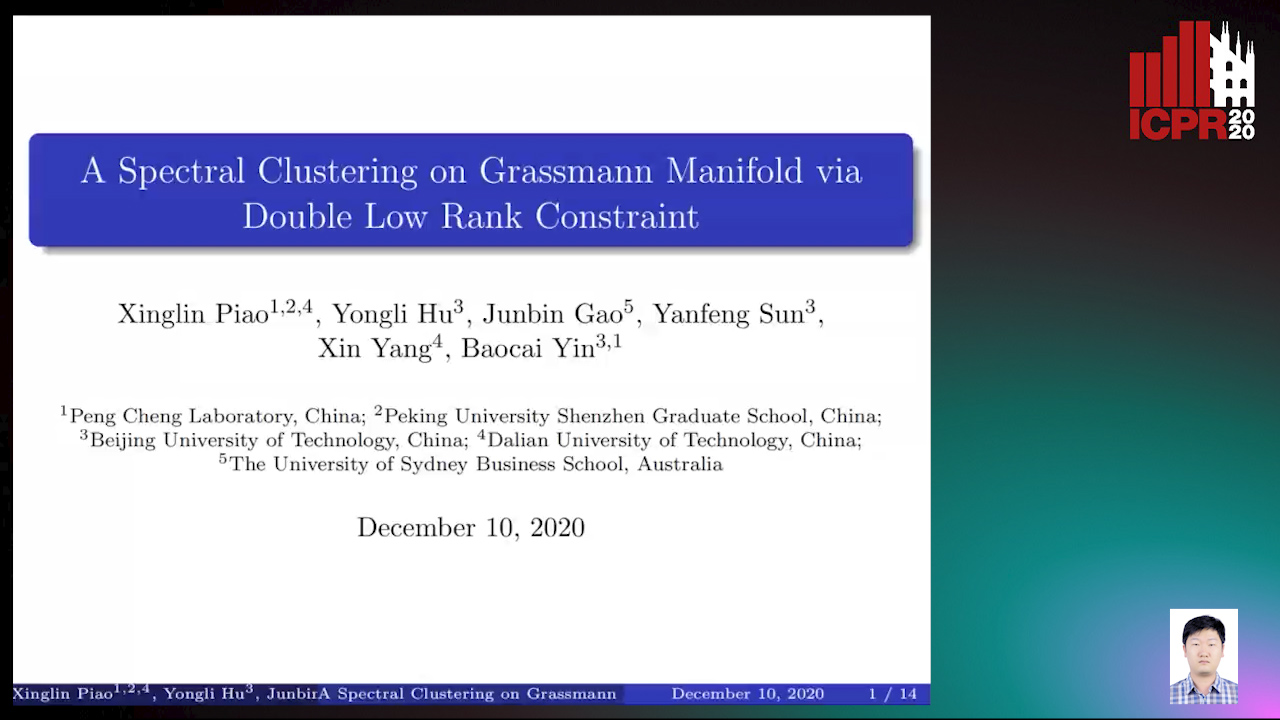
Auto-TLDR; Double Low Rank Representation for High-Dimensional Data Clustering on Grassmann Manifold
Double Manifolds Regularized Non-Negative Matrix Factorization for Data Representation
Jipeng Guo, Shuai Yin, Yanfeng Sun, Yongli Hu
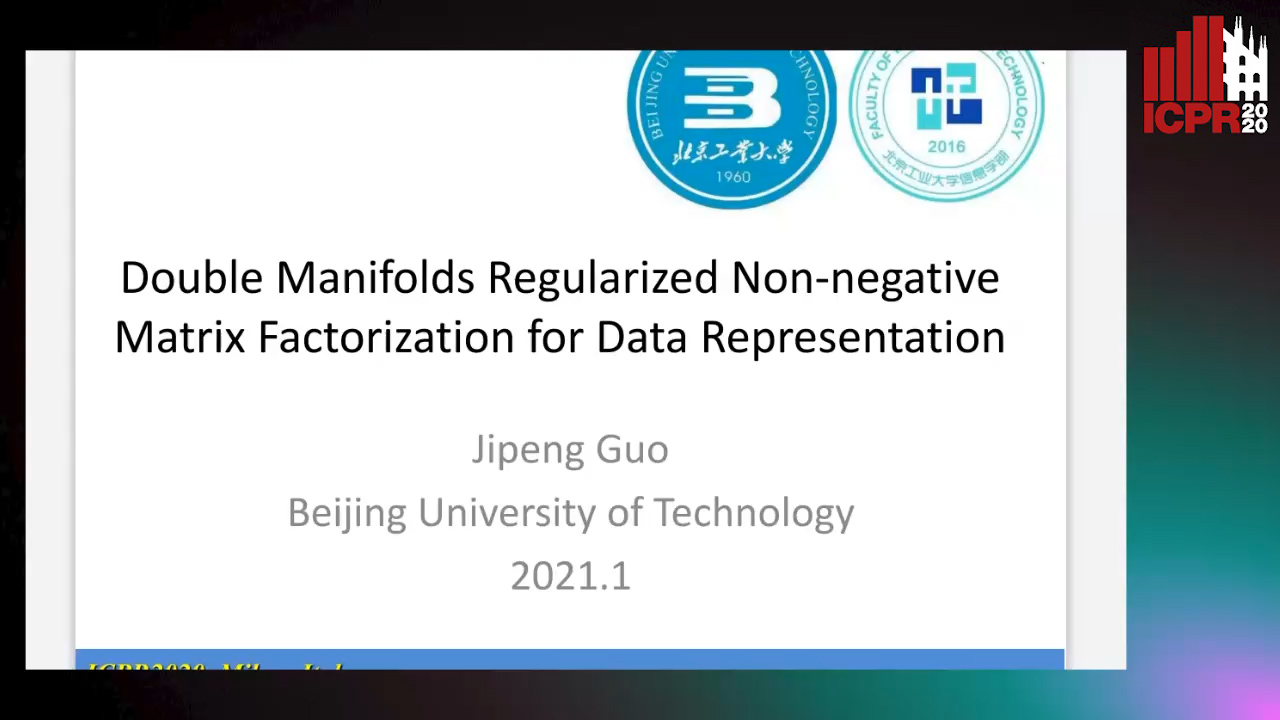
Auto-TLDR; Double Manifolds Regularized Non-negative Matrix Factorization for Clustering
Abstract Slides Poster Similar
Feature Extraction by Joint Robust Discriminant Analysis and Inter-Class Sparsity

Auto-TLDR; Robust Discriminant Analysis with Feature Selection and Inter-class Sparsity (RDA_FSIS)
Subspace Clustering Via Joint Unsupervised Feature Selection
Wenhua Dong, Xiaojun Wu, Hui Li, Zhenhua Feng, Josef Kittler

Auto-TLDR; Unsupervised Feature Selection for Subspace Clustering
Fast Subspace Clustering Based on the Kronecker Product
Lei Zhou, Xiao Bai, Liang Zhang, Jun Zhou, Edwin Hancock

Auto-TLDR; Subspace Clustering with Kronecker Product for Large Scale Datasets
Abstract Slides Poster Similar
Feature Extraction and Selection Via Robust Discriminant Analysis and Class Sparsity

Auto-TLDR; Hybrid Linear Discriminant Embedding for supervised multi-class classification
Abstract Slides Poster Similar
Soft Label and Discriminant Embedding Estimation for Semi-Supervised Classification
Fadi Dornaika, Abdullah Baradaaji, Youssof El Traboulsi

Auto-TLDR; Semi-supervised Semi-Supervised Learning for Linear Feature Extraction and Label Propagation
Abstract Slides Poster Similar
Webly Supervised Image-Text Embedding with Noisy Tag Refinement
Niluthpol Mithun, Ravdeep Pasricha, Evangelos Papalexakis, Amit Roy-Chowdhury
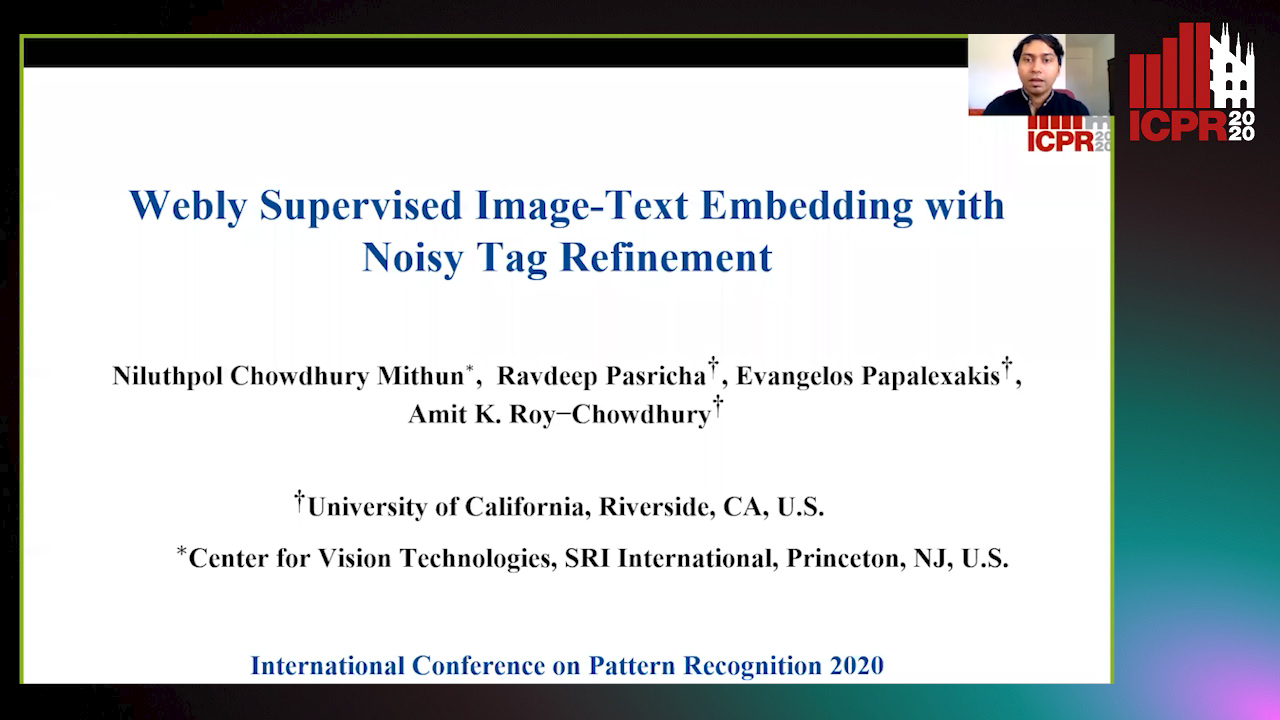
Auto-TLDR; Robust Joint Embedding for Image-Text Retrieval Using Web Images
A Distinct Discriminant Canonical Correlation Analysis Network Based Deep Information Quality Representation for Image Classification
Lei Gao, Zheng Guo, Ling Guan Ling Guan

Auto-TLDR; DDCCANet: Deep Information Quality Representation for Image Classification
Abstract Slides Poster Similar
Directionally Paired Principal Component Analysis for Bivariate Estimation Problems
Navdeep Dahiya, Yifei Fan, Samuel Bignardi, Tony Yezzi, Romeil Sandhu

Auto-TLDR; Asymmetrically-Paired Principal Component Analysis for Linear Dimension-Reduction
Abstract Slides Poster Similar
Label Self-Adaption Hashing for Image Retrieval
Jianglin Lu, Zhihui Lai, Hailing Wang, Jie Zhou

Auto-TLDR; Label Self-Adaption Hashing for Large-Scale Image Retrieval
Abstract Slides Poster Similar
Fast Discrete Cross-Modal Hashing Based on Label Relaxation and Matrix Factorization
Donglin Zhang, Xiaojun Wu, Zhen Liu, Jun Yu, Josef Kittler

Auto-TLDR; LRMF: Label Relaxation and Discrete Matrix Factorization for Cross-Modal Retrieval
Classification and Feature Selection Using a Primal-Dual Method and Projections on Structured Constraints
Michel Barlaud, Antonin Chambolle, Jean_Baptiste Caillau

Auto-TLDR; A Constrained Primal-dual Method for Structured Feature Selection on High Dimensional Data
Abstract Slides Poster Similar
Dependently Coupled Principal Component Analysis for Bivariate Inversion Problems
Navdeep Dahiya, Yifei Fan, Samuel Bignardi, Tony Yezzi, Romeil Sandhu
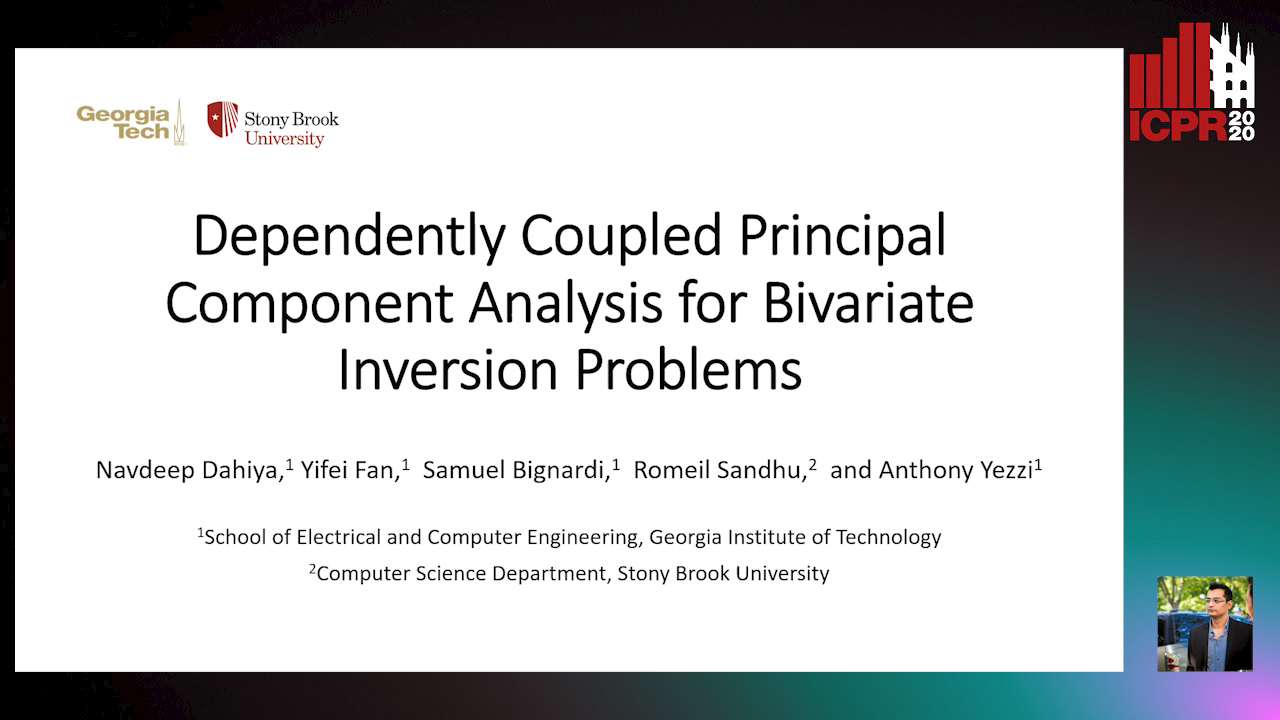
Auto-TLDR; Asymmetric Principal Component Analysis between Paired Data in an Asymmetric manner
Abstract Slides Poster Similar
Object Classification of Remote Sensing Images Based on Optimized Projection Supervised Discrete Hashing
Qianqian Zhang, Yazhou Liu, Quansen Sun

Auto-TLDR; Optimized Projection Supervised Discrete Hashing for Large-Scale Remote Sensing Image Object Classification
Abstract Slides Poster Similar
Joint Learning Multiple Curvature Descriptor for 3D Palmprint Recognition
Lunke Fei, Bob Zhang, Jie Wen, Chunwei Tian, Peng Liu, Shuping Zhao

Auto-TLDR; Joint Feature Learning for 3D palmprint recognition using curvature data vectors
Abstract Slides Poster Similar
Supervised Feature Embedding for Classification by Learning Rank-Based Neighborhoods
Ghazaal Sheikhi, Hakan Altincay

Auto-TLDR; Supervised Feature Embedding with Representation Learning of Rank-based Neighborhoods
T-SVD Based Non-Convex Tensor Completion and Robust Principal Component Analysis
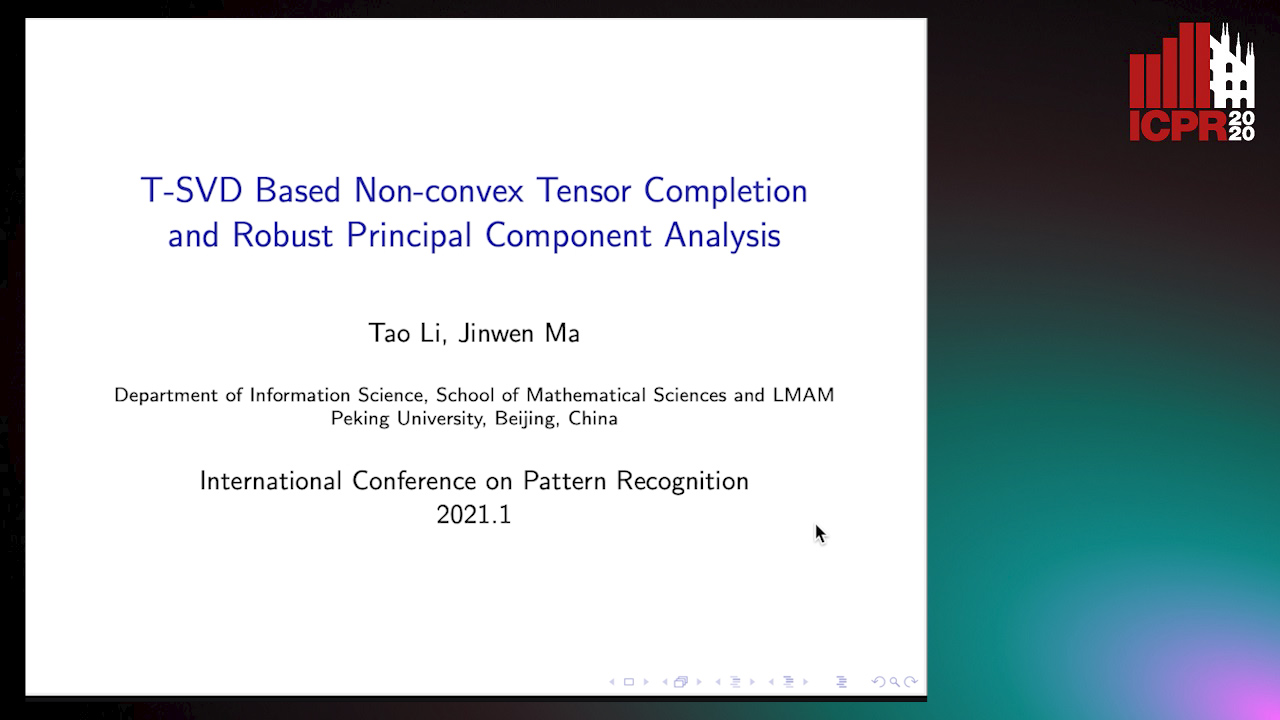
Auto-TLDR; Non-Convex tensor rank surrogate function and non-convex sparsity measure for tensor recovery
Abstract Slides Poster Similar
More Correlations Better Performance: Fully Associative Networks for Multi-Label Image Classification

Auto-TLDR; Fully Associative Network for Fully Exploiting Correlation Information in Multi-Label Classification
Abstract Slides Poster Similar
Discrete Semantic Matrix Factorization Hashing for Cross-Modal Retrieval
Jianyang Qin, Lunke Fei, Shaohua Teng, Wei Zhang, Genping Zhao, Haoliang Yuan

Auto-TLDR; Discrete Semantic Matrix Factorization Hashing for Cross-Modal Retrieval
Abstract Slides Poster Similar
Scalable Direction-Search-Based Approach to Subspace Clustering

Auto-TLDR; Fast Direction-Search-Based Subspace Clustering
Unveiling Groups of Related Tasks in Multi-Task Learning
Jordan Frecon, Saverio Salzo, Massimiliano Pontil

Auto-TLDR; Continuous Bilevel Optimization for Multi-Task Learning
Abstract Slides Poster Similar
Snapshot Hyperspectral Imaging Based on Weighted High-Order Singular Value Regularization
Hua Huang, Cheng Niankai, Lizhi Wang

Auto-TLDR; High-Order Tensor Optimization for Hyperspectral Imaging
Abstract Slides Poster Similar
Cross-spectrum Face Recognition Using Subspace Projection Hashing
Hanrui Wang, Xingbo Dong, Jin Zhe, Jean-Luc Dugelay, Massimo Tistarelli

Auto-TLDR; Subspace Projection Hashing for Cross-Spectrum Face Recognition
Abstract Slides Poster Similar
A Multi-Task Multi-View Based Multi-Objective Clustering Algorithm
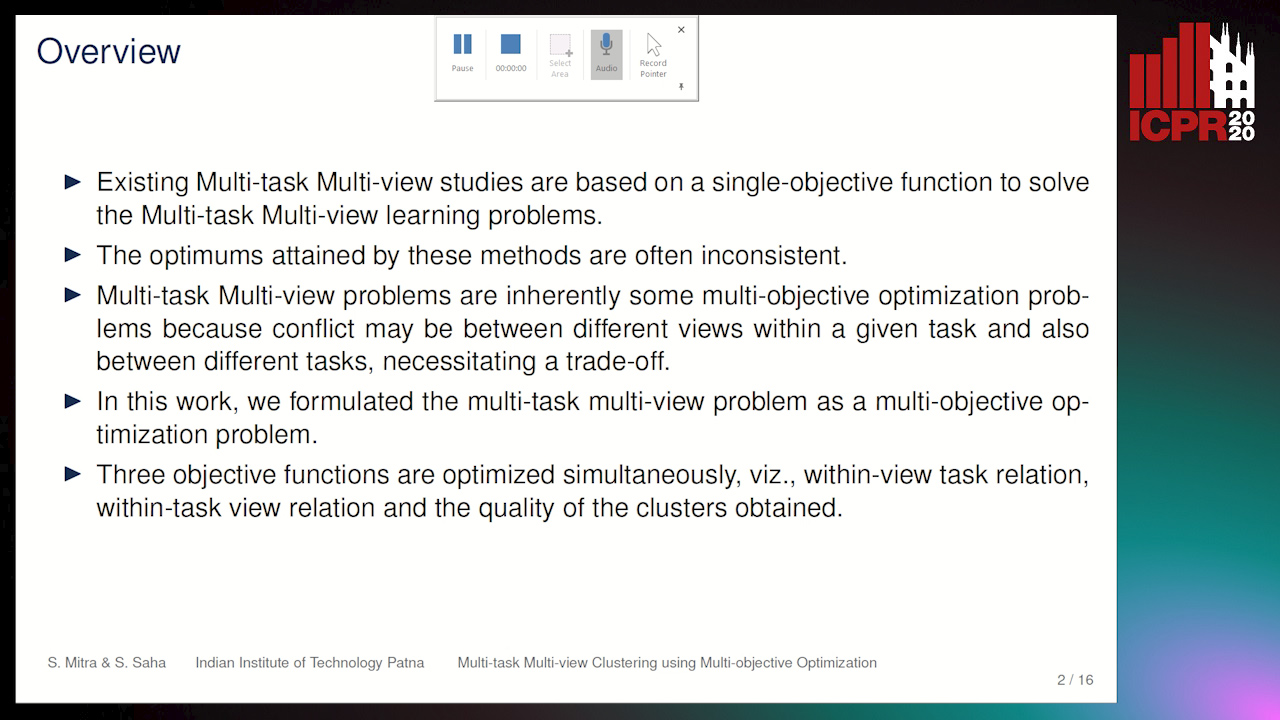
Auto-TLDR; MTMV-MO: Multi-task multi-view multi-objective optimization for multi-task clustering
Abstract Slides Poster Similar
Subspace Clustering for Action Recognition with Covariance Representations and Temporal Pruning
Giancarlo Paoletti, Jacopo Cavazza, Cigdem Beyan, Alessio Del Bue

Auto-TLDR; Unsupervised Learning for Human Action Recognition from Skeletal Data
Sparse-Dense Subspace Clustering
Shuai Yang, Wenqi Zhu, Yuesheng Zhu
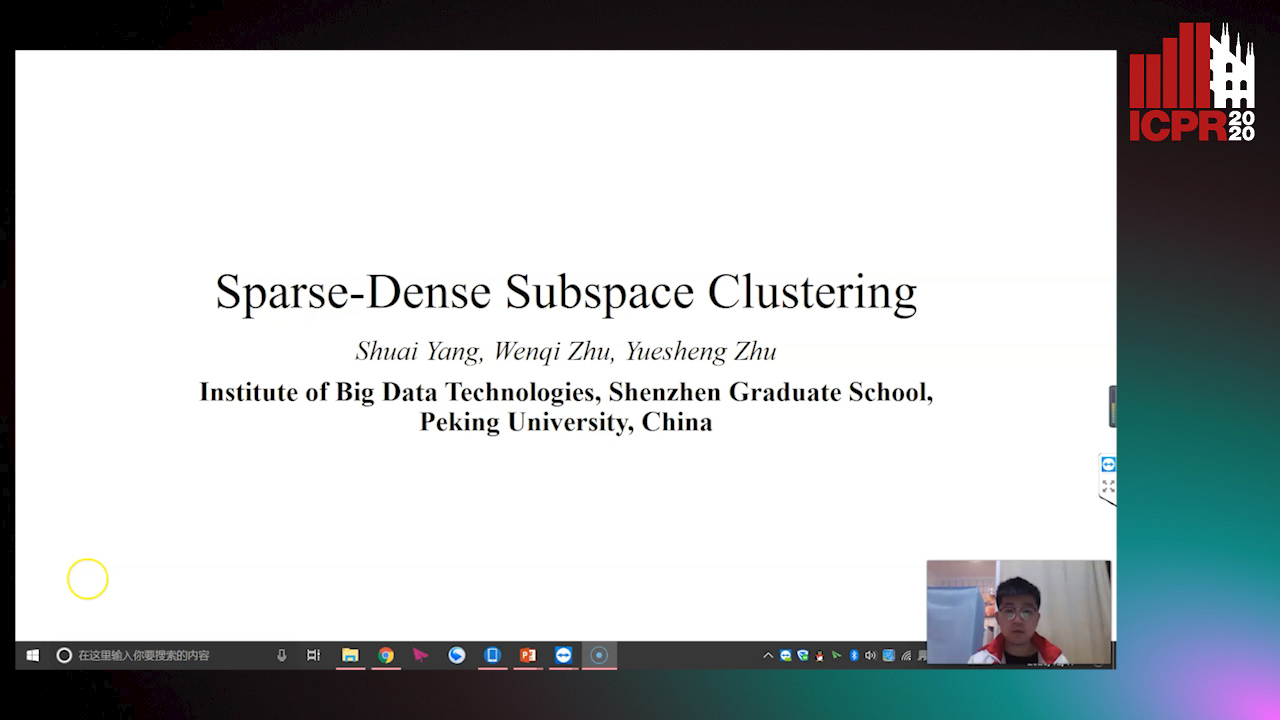
Auto-TLDR; Sparse-Dense Subspace Clustering with Piecewise Correlation Estimation
Abstract Slides Poster Similar
Person Recognition with HGR Maximal Correlation on Multimodal Data
Yihua Liang, Fei Ma, Yang Li, Shao-Lun Huang

Auto-TLDR; A correlation-based multimodal person recognition framework that learns discriminative embeddings of persons by joint learning visual features and audio features
Abstract Slides Poster Similar
Exploiting Elasticity in Tensor Ranks for Compressing Neural Networks
Jie Ran, Rui Lin, Hayden Kwok-Hay So, Graziano Chesi, Ngai Wong

Auto-TLDR; Nuclear-Norm Rank Minimization Factorization for Deep Neural Networks
Abstract Slides Poster Similar
JECL: Joint Embedding and Cluster Learning for Image-Text Pairs
Sean Yang, Kuan-Hao Huang, Bill Howe

Auto-TLDR; JECL: Clustering Image-Caption Pairs with Parallel Encoders and Regularized Clusters
Ultrasound Image Restoration Using Weighted Nuclear Norm Minimization
Hanmei Yang, Ye Luo, Jianwei Lu, Jian Lu

Auto-TLDR; A Nonconvex Low-Rank Matrix Approximation Model for Ultrasound Images Restoration
Sketch-Based Community Detection Via Representative Node Sampling
Mahlagha Sedghi, Andre Beckus, George Atia

Auto-TLDR; Sketch-based Clustering of Community Detection Using a Small Sketch
Abstract Slides Poster Similar
Learning Sign-Constrained Support Vector Machines
Kenya Tajima, Kouhei Tsuchida, Esmeraldo Ronnie Rey Zara, Naoya Ohta, Tsuyoshi Kato

Auto-TLDR; Constrained Sign Constraints for Learning Linear Support Vector Machine
Supervised Domain Adaptation Using Graph Embedding
Lukas Hedegaard, Omar Ali Sheikh-Omar, Alexandros Iosifidis

Auto-TLDR; Domain Adaptation from the Perspective of Multi-view Graph Embedding and Dimensionality Reduction
Abstract Slides Poster Similar
Randomized Transferable Machine
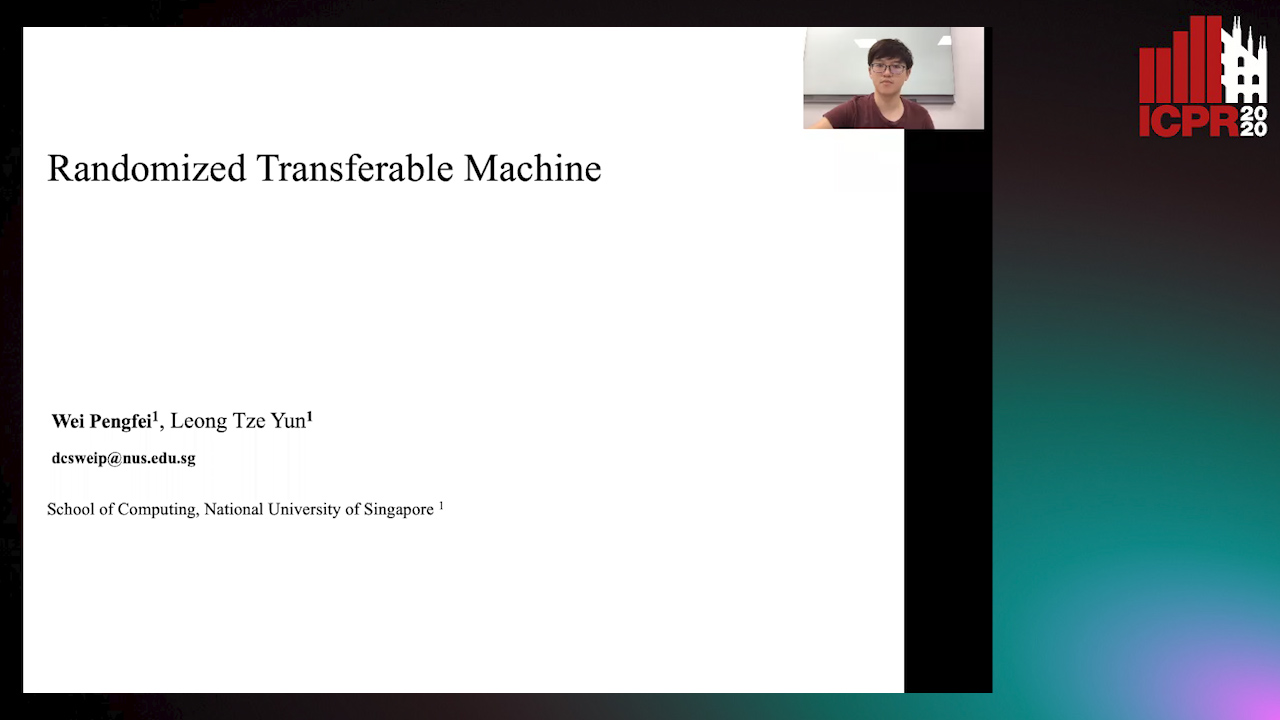
Auto-TLDR; Randomized Transferable Machine for Suboptimal Feature-based Transfer Learning
Abstract Slides Poster Similar
Nonlinear Ranking Loss on Riemannian Potato Embedding
Byung Hyung Kim, Yoonje Suh, Honggu Lee, Sungho Jo

Auto-TLDR; Riemannian Potato for Rank-based Metric Learning
Abstract Slides Poster Similar
Vision-Based Multi-Modal Framework for Action Recognition
Djamila Romaissa Beddiar, Mourad Oussalah, Brahim Nini

Auto-TLDR; Multi-modal Framework for Human Activity Recognition Using RGB, Depth and Skeleton Data
Abstract Slides Poster Similar
Object Detection on Monocular Images with Two-Dimensional Canonical Correlation Analysis

Auto-TLDR; Multi-Task Object Detection from Monocular Images Using Multimodal RGB and Depth Data
Abstract Slides Poster Similar
Hybrid Approach for 3D Head Reconstruction: Using Neural Networks and Visual Geometry
Oussema Bouafif, Bogdan Khomutenko, Mohammed Daoudi

Auto-TLDR; Recovering 3D Head Geometry from a Single Image using Deep Learning and Geometric Techniques
Abstract Slides Poster Similar
Adversarial Encoder-Multi-Task-Decoder for Multi-Stage Processes
Andre Mendes, Julian Togelius, Leandro Dos Santos Coelho

Auto-TLDR; Multi-Task Learning and Semi-Supervised Learning for Multi-Stage Processes
A Unified Framework for Distance-Aware Domain Adaptation
Fei Wang, Youdong Ding, Huan Liang, Yuzhen Gao, Wenqi Che

Auto-TLDR; distance-aware domain adaptation
Abstract Slides Poster Similar
AdaFilter: Adaptive Filter Design with Local Image Basis Decomposition for Optimizing Image Recognition Preprocessing
Aiga Suzuki, Keiichi Ito, Takahide Ibe, Nobuyuki Otsu
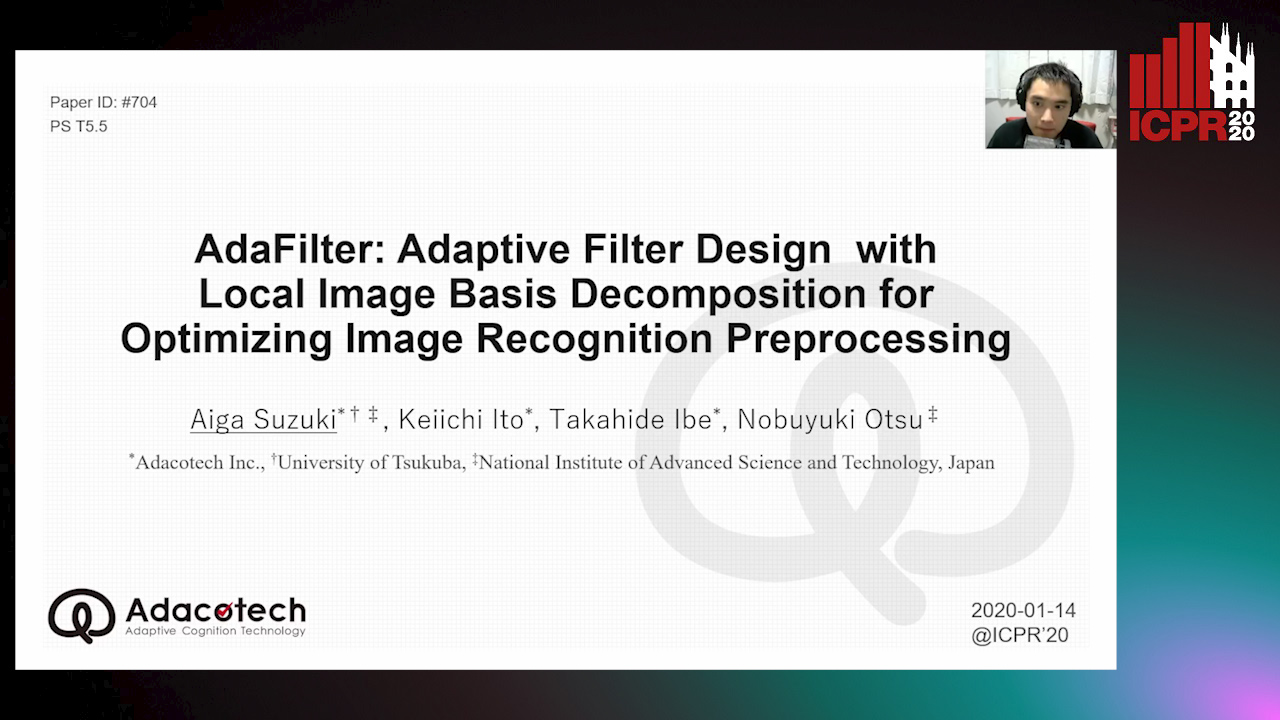
Auto-TLDR; Optimal Preprocessing Filtering for Pattern Recognition Using Higher-Order Local Auto-Correlation
Abstract Slides Poster Similar
Learning Sparse Deep Neural Networks Using Efficient Structured Projections on Convex Constraints for Green AI
Michel Barlaud, Frederic Guyard

Auto-TLDR; Constrained Deep Neural Network with Constrained Splitting Projection
Abstract Slides Poster Similar
Heterogeneous Graph-Based Knowledge Transfer for Generalized Zero-Shot Learning
Junjie Wang, Xiangfeng Wang, Bo Jin, Junchi Yan, Wenjie Zhang, Hongyuan Zha

Auto-TLDR; Heterogeneous Graph-based Knowledge Transfer for Generalized Zero-Shot Learning
Abstract Slides Poster Similar
Feature-Aware Unsupervised Learning with Joint Variational Attention and Automatic Clustering
Wang Ru, Lin Li, Peipei Wang, Liu Peiyu

Auto-TLDR; Deep Variational Attention Encoder-Decoder for Clustering
Abstract Slides Poster Similar
Adaptive Context-Aware Discriminative Correlation Filters for Robust Visual Object Tracking
Tianyang Xu, Zhenhua Feng, Xiaojun Wu, Josef Kittler
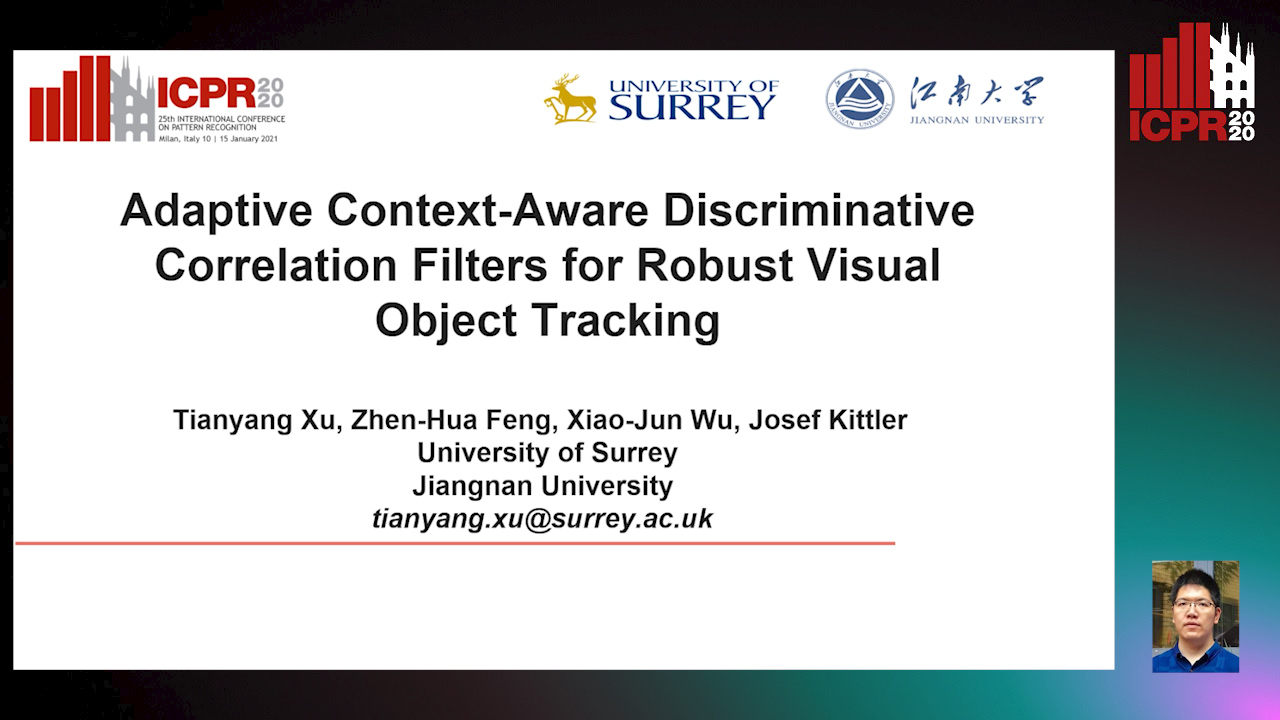
Auto-TLDR; ACA-DCF: Adaptive Context-Aware Discriminative Correlation Filter with complementary attention mechanisms
Abstract Slides Poster Similar
Prior Knowledge about Attributes: Learning a More Effective Potential Space for Zero-Shot Recognition

Auto-TLDR; Attribute Correlation Potential Space Generation for Zero-Shot Learning
Abstract Slides Poster Similar